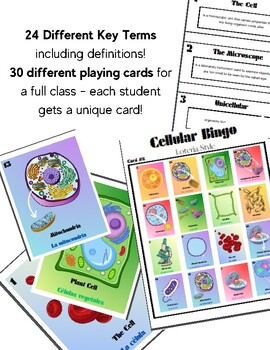Cellular Vocab Bingo - Loteria Style
Salsburys Science Corner
7 Followers
Grade Levels
4th - 12th
Subjects
Resource Type
Standards
NGSSMS-LS1-2
NGSSMS-LS1-3
NGSSMS-LS1-1
Formats Included
- PDF
Pages
64 pages
Salsburys Science Corner
7 Followers
Description
Included:
- 24 Key Term Cards
- 24 Definitions
- A set of 30 Bingo Cards
Key Term Cards and Definitions:
- Each Key Term card is available with a matching definition.
- I printed out the key term cards and the definitions.
- Then, I cut out and taped the definition to the back of each key term card.
- I then laminated my cards but you could choose not to.
Bingo Cards:
- I made a class set of 30 Bingo Cards.
- I printed them in color and them laminated them with dry-erase laminating sheets.
- Traditionally, Loteria is played using beans as markers on the bingo squares but you could also use dry erase markers.
Total Pages
64 pages
Answer Key
N/A
Teaching Duration
N/A
Report this resource to TPT
Reported resources will be reviewed by our team. Report this resource to let us know if this resource violates TPT’s content guidelines.
Standards
to see state-specific standards (only available in the US).
NGSSMS-LS1-2
Develop and use a model to describe the function of a cell as a whole and ways the parts of cells contribute to the function. Emphasis is on the cell functioning as a whole system and the primary role of identified parts of the cell, specifically the nucleus, chloroplasts, mitochondria, cell membrane, and cell wall. Assessment of organelle structure/function relationships is limited to the cell wall and cell membrane. Assessment of the function of the other organelles is limited to their relationship to the whole cell. Assessment does not include the biochemical function of cells or cell parts.
NGSSMS-LS1-3
Use argument supported by evidence for how the body is a system of interacting subsystems composed of groups of cells. Emphasis is on the conceptual understanding that cells form tissues and tissues form organs specialized for particular body functions. Examples could include the interaction of subsystems within a system and the normal functioning of those systems. Assessment does not include the mechanism of one body system independent of others. Assessment is limited to the circulatory, excretory, digestive, respiratory, muscular, and nervous systems.
NGSSMS-LS1-1
Conduct an investigation to provide evidence that living things are made of cells; either one cell or many different numbers and types of cells. Emphasis is on developing evidence that living things are made of cells, distinguishing between living and non-living cells, and understanding that living things may be made of one cell or many and varied cells.





